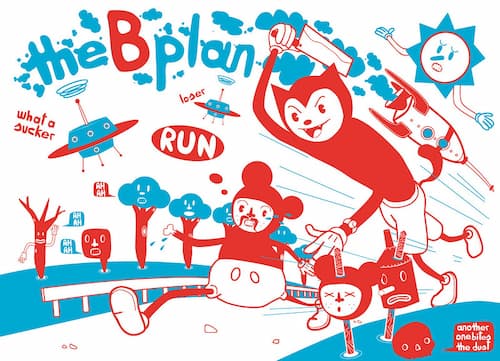Guidelines For Successful Communication With Clients
OK, so this is a yet another article about dealing with clients. But let’s face it — it doesn’t matter how well you can design or code; as a freelancer or if you’re running a digital agency, if you don’t get the client management right, it can spell disaster for your business. By getting it right from the very beginning, you’ll most likely see things flourish.
In a previous article on How to Explain to Clients they are Wrong, I discussed one aspect of client management, but oh my, there are so many and that is why I would like to discuss yet another aspect in this article: how to maintain project productivity and momentum when working with clients.
A Common Scenario
Most of us have been there: we’re working on a project for a client, we plan it, we set down a timeline with milestones and everyone is happy. We then complete our first task that requires feedback and wait for the response on the date mutually agreed, one that would keep the project on schedule… and then it happens. The response doesn’t come, or it does, and it in no way helps the project along. In fact, it actually makes you want to go and hibernate for a few months in a warm safe place and put the client into carbon freeze.

So what can you do to help avoid these Web project crimes? Hopefully, the following tips can save you some stress and ensure that you aren’t completely grey haired by your mid-twenties.
Regular Schedule and Budget Updates
It seems like an obvious one, and something many of us start out doing at the beginning of a Web project, but as the workload builds up and other projects on your plate are starting or ending, it can often fall by the wayside. This might not seem to be a problem in the short run, but it will become one the minute something doesn’t go according to plan.
From the very beginning it’s really important to remain disciplined and send your client a revised project schedule and updated budget every week. In this update you could highlight the following:
- Completed tasks from the previous week.
- Budget spent and budget remaining on each phase, e.g. design, functional specification etc.
- Planned tasks for the following week and who is responsible, you or the client.
- Any tasks that are slipping over schedule or over budget, and if so why. Also consider the potential impact on the project.
It may seem a little over the top to do this the week after the project starts, as very little has changed from the initial schedule; but as the project progresses and things inevitably slip, it’s in no way a surprise to the client and makes negotiating additional time or budget a lot less painful.
Buy Now, Don’t Pay Later
Too often I see people running web projects that don’t send weekly schedules and budget updates with it invariably ending up the same way — the project slipping in various places, small places, but building into significant schedule and budget problems over time. Then, after a few months, the client suddenly asks “Are we on track for go-live?” or “Are we on budget?”
This is when the smelly stuff hits the fan as the client, quite rightly, says “I assumed all was OK as you hadn’t mentioned anything before!” Not only do you have to fumble your way through an awkward phone call or meeting but you’ve put yourself in a weak position and damage has been done to your relationship with the client and their level of trust in you. Bad times, and all because you weren’t disciplined and clear from day one.
The Client is a Team Member
Constantly highlighting tasks that need attention by a certain date from a client, with the impact of non-action being clear, really helps keep the client focused on completing what they need to do in the short-term. At the same time, it helps you maintain the bigger picture view of the project — after all, clients inevitably have a business to run and so your job is to make things as simple for them as possible by essentially managing them and their project tasks as if they were a team member. Oddly enough, in my experience, most clients actually appreciate you managing them.
From the initial stage of the project, it is a good idea to make it clear to the clients that you see them as a team member of the project and expect cooperation and support during the entire project. This also means that you should expect to have a dedicated person in the client’s company who will be answering your questions, and who will be the only person answering your questions. This will help a lot during the whole process and will prevent problems and misunderstandings down the road.
Shifts In Schedule Aren’t Always Bad
Slipping project schedules are often associated with a project going wrong, but it doesn’t always have to be. Remember, an initial go-live date set out in an initial schedule isn’t always as important as the client has said it is. Sometimes other more important things pop up, and these things often need to be carefully examined, discussed, resolved and implemented — and often it just takes more time than expected.

If a project you’re running is in danger of missing milestone dates due to lack of timely client feedback, as long as you have constantly communicated impact of late feedback you can always approach the subject of a new go-live or milestone completion date with the client and see how it plays out. Argue that the quality of your work is very important to you and you wouldn’t want to compromise the quality of the project due to the communication problems. It’s a good idea to find time to review the work done, discuss the problems in communication and find solutions to improve the workflow in the next stage of the project.
The more important the deadline is to the client, the clearer your time requirements and feedback requirements should be in the initial stage of the project.
In my work, I find myself often starting a conversation along these lines expecting “the go-live date is fixed” reply, but instead got a more reasonable response if the client has been given regular updates and knows that the main reasons for the delay are not design agency’s lack of discipline, but rather company’s late feedback or other reasonable problems. Give it a go: you may be pleasantly surprised at the power of disciplined and honest regular updates.
Help the Client Out, Be Pro-active
This is an important point: always be willing to help the client out with tasks that you shouldn’t necessarily be doing or are being paid to do. Common examples of this include microcopy, icons, print version of the website, small teaser images and lower level page banners.
A hard-nosed stubborn Web Project Manager will insist that all images and copy, including the little bits and pieces like thank you e-mail copy and success messages, are delivered by a date in order to remain on schedule, and when these aren’t delivered, then the project could well be delivered late and it’s all the fault of the client. Well, maybe it is, but do we actually have to wait for the client for every single bit of the project?

You use the Web every single day, you’re a Web professional, you know the project inside out and you’ve learn about the target audience from the meetings with clients. This knowledge enables you to assist the client when timelines are slipping by, getting these small things created for them if necessary.
Now of course in an ideal world all of these elements would be paid for and carefully crafted by designers, UX teams and copywriters, but this is just not the way it usually works in practice. Sometimes commercial reality for both your business and the client must take precedent and it’s time to roll your sleeves up.
Get Real, Get Commercial
For the sake of keeping a project worth thousands on track, and if you are sensing these could be stalling points, go ahead and pre-empt the delay in getting the smaller things on time by preparing some example pieces of microcopy and submitting to the client for approval. Yes, I hear you, it’s not your job to do, but if you want to save the project, sometimes it’s your responsibility to take care of it in a reasonable, professional way. Or how about producing a lovely content template spreadsheet for the client to fill in rather than asking them to work on a blank canvas (if you can call MS Word a canvas).
Clear it with your boss that by getting a designer or copywriter to work for a couple of hours unbillable will keep a project and cash flow on target — rarely will the request be denied and the client will probably really appreciate you taking the lead on things that, to them and their business plan, are small details.
As long as the time you spend helping the client out balances out financially in the long-term, it’s always a perfectly good solution to keeping a project on track when necessary and encourages a positive relationship with the client.
Dealing With Multiple Stakeholders
Often when working for a client, you only interact with one or two persons but they have to report to many more. A common cause for delays in web projects is the time it takes your primary contact to get their superiors to review, provide feedback or approve portions of work and communicate this back to you.
With the best will in the world from all parties this can be incredibly frustrating and the time to get the feedback you need isn’t always easy to do with communication lines. It can also be because your primary contact will encounter not only “design by committee” but also “decision by committee”, on the smallest of things. The good news is that there are ways to combat this.
Identify The Client-side Project Manager
First of all, it’s a good idea to make sure you ask who will be the client-side Project Manager and if this person has decision making authority as early as possible in the project, preferably at the kick-off meeting. In some situations, especially in boardrooms with Senior Directors, plus your contact sitting there, this can feel like an awkward question to ask but it’s vitally important to do so.
Of course, the Directors will identify your contact as the Project Manager their end, but if they hesitate on confirming that they have decision making authority, quickly but calmly communicate that it’s not a problem and you’ll just have to work decision making time into the timeline. Although this is a bit of a fluffy statement, it sets you up to raise it at a later date if it becomes an issue with regards to timelines and also gives your contact some leverage when pushing their probably very busy bosses for timely feedback.
Make Your Primary Contact Look Good
Another piece of client management advice that is very helpful for facilitating a smooth project, is to always do your best to make your primary contact look good to their superiors — even if the primary contact made some mistakes or doesn’t communicate things clearly enough.
What this means is that regardless of what calibre your primary contact is regarding running things from their side, always try to hit their deadlines, allow them to take credit for your suggestions and ideas (within reason) and just generally give them the best service you can. This isn’t just a good, ethical and worthwhile approach to providing a service, but if you make your primary contact look good to their superiors, they will absolutely love you for it. Consequently, they will put more effort into keeping the relationship fruitful by making things smooth for you and ultimately want to keep working with you rather than someone else. And that’s a project productivity win and long-term client relationship win as well.

When You Just Can’t Roll A Contact In Glitter
In the absolute worst case scenario it may be necessary to consider going above the primary contact’s head, to their boss, in order to get things moving again or increase the speed of feedback. But use this approach with massive amounts of caution! Obviously, it has the potential to permanently damage the relationship you have with the client, including their boss, and while they may begin to provide feedback quicker, some more unscrupulous clients will make sure to cause you stress and grief in other ways as punishment and revenge, and even nice ones will be really annoyed to say the least.
The only reasonable advice in such situation is to ask the design agency’s head to call the company and insist on sorting things out to keep the project’s flow as smooth as possible and avoid problems down the road. However, this should certainly be the last resort.
If you work for a company, you can be certain that somebody senior will be able to strike up a conversation with someone senior on the client side and approach the subject in a much more subtle way than you could, if you can leave that to the silver tongues of the world.
If you’re a freelancer, then, well, you’re in a really tough position and it’s a good idea to try to somehow manufacture a reason you need to speak to the someone senior and very gently sway the conversation to how the project is going, and ease into the part of the conversation that explains how busy they all must be, how everything’s going fine and if one improvement could be made then it would be response time on certain aspects…
If this technique sounds a little fluffy and a bit underhand, that’s because there is definitely no single right way to do it, and it does feel a little wrong. But if executed the right way it can have the effect desired with no egos bruised.
Face-to-Face Sessions And Meetings
When you encounter a client that just seems impossible to get timely responses from, it’s usually not because they are unprofessional, but rather because of their own personal hectic schedule of internal work which is constantly winning their attention over this ‘outsourced’ project.
One approach you can take when the list of responses and decisions you’re waiting for are just not coming, is to arrange the ultimate solution to the problem — a face to face client session or meeting.
Session And Meeting Management
The truth of the matter is that some clients you literally need to drag into your office and not let them leave until you have all the feedback and decisions you need. More often than not these sessions can be incredibly productive and get a stalled project right back on track.
When having a face to face meeting session with a client to get a project back on track, it’s important to clearly define the reason for the meeting and provide clients with enough time to prepare everything they need beforehand. It’s crucial to maintain focus on this main goal during the meeting and not let it get sidetracked by any other business. So if the conversation suddenly veers off course, make sure to pick your moment and reign it back in, perhaps by noting down the topic or question and postponing the other topic after you’ve got to the end of the agenda.
Weekly Client Meetings
Another meeting-based solution to help with client and project productivity is to arrange weekly client meetings. It’s not necessary to arrange them face to face but personally I’ve found these more effective than phone calls.
Admittedly, not all weekly meetings are good. To avoid getting caught in the hellish, lengthy, counter-productive weekly meetings, start them with a strong statement: encourage all participants to keep focused. Set a specific timeframe for the meetings to make sure that they are not taking too much time: usually 25–40 minutes is more than enough to discuss the most critical things that require clarification.
When I first came across the concept of weekly meetings, or having a focused call with a client, I felt that it just wasn’t worth it and would take a lot of work time that could rather be used for more productive and meaningful work. I assumed that an hour each week would feel very much like in every other meeting I’d been at and hence result in few decisions and more questions than answers. I must admit that I was wrong.

If handled correctly with strong focus on being efficient and to the point, a weekly meeting or call can be incredibly beneficial to a project’s momentum, and for very simple reasons. They:
- Increase the project’s perceived importance in your and your agency’s field of vision.
- Reduce the temptation to delay something on that project for the sake of another as you’ll have to report on progress in less than a week, e.g. schedule and budget updates.
- Allow for a constant flow of review and decision making at regular intervals, hence making planning easier.
- Rapidly encourage a good working rapport with a client making things easier for both sides.
Overall, the main benefit of weekly meetings, and probably the reason I initially resisted them so much, is that they actually keep the pressure on to complete a project and stick to the project plan. And that’s a damn good thing. Once I saw the difference in how quick a project with effective weekly meetings was delivered over one that was allowed to be delayed due to the lack of regular communication, I embraced them and found myself zipping through projects quickly.
It’s Not Always the Client That’s the Bottleneck!
Despite it’s often very comfortable to criticize the client for delays (and it is sometimes very true and therapeutic), it’s often not the client that holds up a project. Keep your worklfow organized and review your internal processes every month, trying to find bottlenecks and improve the flow of your projects. Criticize yourself first and never criticize your clients. Mutual respect and honesty is much more helpful than putting labels on things; be professional and make sure that your work is always professional as well.
Non-Diagnosed Medical Conditions Help
One obvious way to ensure that you don’t become the bottleneck in a project is to be so organized that if a medical professional were to observe you for a week they would most likely prescribe you pills and a psychiatrist for obsessive behaviour.
Being organised is a discipline but, in my humble opinion, also a character trait that can’t be taught easily. You either are an organized person or you’re not. While everyone can’t be built the same way, if you want to maintain productivity on a project, you need to find some mechanism to keep things in flow and on track. Use simple tools and use them well. For instance, sometimes a simple .txt-file is more than enough for keeping deadlines and managing to-do lists.
So what are the important things you can do to to get more organized?
- Delegate tasks if you have someone to delegate to, even ones you enjoy.
- Seek support from your superior if you’re overwhelmed with work ——they’ll help you prioritize.
- Try using a workload management system such as GTD or Pomodoro.
- Review your project schedules daily, adjust them and communicate them to the client.
- Review your to-do list daily and shuffle things around to create a realistic completion list for the day.
- Avoid dealing with ad hoc requests the minute they come in, often they’re not as urgent as they seem.
- Have a consistent project folder structure and file naming convention.
- Follow consistent processes, so you get better at estimating how long similar tasks in the future will take: e.g. creating a proposal or functional specification which are dependent on size of the project.
- Get a great pair of headphones and listen to the music you love, e.g. the Star Wars soundtrack (or Predator soundtrack if you fancy something a little fruity).
Get to the chopper!
Had A Bad Week? Be Honest About It
If you’ve done everything you could, but just can’t keep on top of things and a project is slipping slightly, just be honest with the clients and tell them you’ve had “one of those weeks”.
Clients are more approachable and understanding than you might think. If you sincerely tell a client the reason for the delay, they will completely understand; be professional and make sure to provide clients with a new (realistic) deadline when you will deliver for sure and stick to it.
Failing to deliver a second or even third time is a pretty good sign to a client that they may have hired the wrong person. More importantly, it should be an alarm bell for you: your way of working isn’t working, be it by not being organized, being too optimistic with deadlines or just taking on too much work. Analyze the problem and adjust your workflow appropriately. That’s your wake-up call that you need to change something. And if you react quickly, you’ll grow as a professional and will be able to keep your current project.
What tips do you have for maintaining productivity on web projects when working with clients?
Related Posts
- Organization Tips For Web Designers
- 37 Productivity Tips for Working From Anywhere
- When Clients Mess Things Up
- 6 Amazing Techniques to Staying Happy During a Stressful Project
Further Reading
- 8 Strategies For Successful Relations With Clients
- How To Deliver Exceptional Client Service
- 15 Habits Of Professional Freelancers
- How To Successfully Educate Your Clients On Web Development


 SurveyJS: White-Label Survey Solution for Your JS App
SurveyJS: White-Label Survey Solution for Your JS App Agent Ready is the new Headless
Agent Ready is the new Headless





